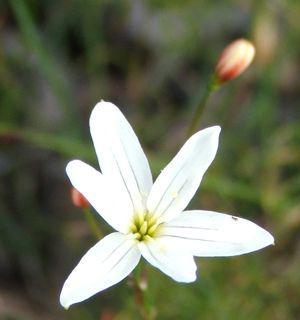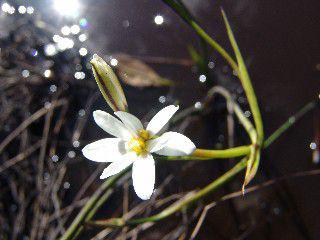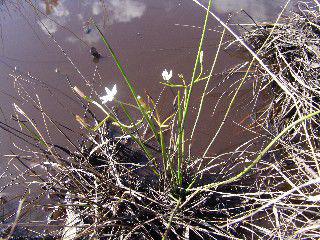Pauridia aquatica
Pauridia aquatica (L.f.) Snijman & Kocyan
Family: Hypoxidaceae
Common names: Cape star (Eng.); sterretjie, vleiblommetjie, vlei-uintjie, watersterblom, watersterretjie (Afr.)
Introduction
Pauridia aquatica is a small geophytic plant suitable for water gardens and wetlands. Its white, star-shaped flowers with bright yellow centres, make a pretty display and brighten up a winter garden. It was previously known as Spiloxene aquatica (L.f.) Fourc.

Description
Description
Pauridia aquatica is an aquatic geophyte that grows to a height of 100–300 mm. It grows from a fleshy corm which is smooth or has a few, loosely fibrous scales.
It has 2–5 linear, somewhat hollow leaves that are slightly triangular in cross section.

It bears umbels of 2–7, small, star-shaped, white flowers, with green stripes on the underside of the 3 outer petals. The flowers are suspended on long, slender pedicels and subtended by 2 broad, leaf-like bracts.
P. aquatica is one of the Cape’s winter-growing bulbs, and flowers can appear as early as May and continue until November, after which it produces seeds in capsules. The flower stalk bends towards the earth as the capsules open, in order to drop their seeds directly on the ground, or in water. The tiny seeds (0.4–1.0 mm), have a sculptured dark brown coat.
Conservation Status
Status
According to the Red List of southern African plants, Pauridia aquatica is not endangered and has a conservation status of LC (Least Concern), and a population trend that is stable.
Distribution and habitat
Distribution description
Pauridia aquatica is quite commonly found in seasonal pools, ditches, vlei edges and marshes in Namaqualand and the southern, southwestern and Eastern Cape. It can grow best in winter-rainfall regions in, or at the edge of a pond or wetland.

Derivation of name and historical aspects
History
Pauridia aquatica (= Spiloxene aquatica), is a member of the Hypoxidaceae family, which also contains the genera: Curciligo, Empodium, Heliacme, Hypoxidia, Hypoxis, Molineria and Rhodohypoxis, and the recent addition: Sinocurciligo. Although Spiloxene was the largest genus in the family comprising 30 species, the genus Pauridia (2 species), was amplified to include Hypoxis sect. Ianthe, Saniella and Spiloxene.
The name Pauridia is derived from the Greek Pauros = small and idia = dim, relating to the small size of some of the species in the genus. The species name, aquatica, refers to its preferred habitat: living in or under water.
Ecology
Ecology
Puridia aquatica is well adapted to aquatic life with leaves that contain a white spongy pith with plenty of airspaces, allowing them to float. As seasonal pools dry out, the plant is able to survive due to its cormous rootstock, which is replaced annually after every growing season.
The flowers of Pauridia species do not have nectaries, however, the open star-shaped flowers with prominent anthers, are perfect for attracting pollen-collecting insects. During conditions unfavorable for collecting by these insects (cloudy, cold and wet), the flowers close and on warm days, only open during the optimal foraging times from 11am to 4pm. Unfortunately for Pauridia aquatica, their flowers are also frequently visited by beetles which feed on the floral parts.

Uses
Use
There are no known medicinal or magical uses recorded for Pauridia aquatica, however, as a garden plant, it adds interest and beauty. It is suitable for planting in moist areas and on the edges of ponds and streams and brings colour in winter.
Growing Pauridia aquatica
Grow
Propagate by offsets or seed. Offsets are removed during the summer-dormant period and planted in autumn. As offsets form quite slowly, P. aquatica may be propagated by seed to increase numbers. Sow seed in autumn and take care not to sow the fine seed too deeply. Water during the winter-growing period and cease watering during the summer-dormant period. Plants should remain in the seed tray for at least two seasons before transplanting into pots. Plant corms 1–3 cm deep, depending on the size of the corms, in rich but well-drained soil and do not allow them to dry out during the winter months. Seedlings will flower only after the second or third season. Pauridia prefer full sun and will only flower well if they are in this position. They do not tolerate frost.
Pauridia aquatica favour moist places, and often two or more species of Pauridia species will grow together. They will do well at the edge of a shallow pond or even growing right in the water. In their natural habitat, pools are seasonal and the plants die down during the dry summer months. Plant them in a pot and sink this into the water so as to be able to remove them for storage over the summer. It will make a striking pond setting to grow other Pauridia species alongside P. aquatica, although they will all do better in pots. The orange or yellow Pauridia canaliculata and P. capensis, yellow or white with blue centres, would make a beautiful show. Although the individual flowers do not last very long, they bring some colour to the garden during winter and make a brilliant display.
References
- Adamson, R.S. & Salter, T.H (eds). 1950. Flora of the Cape Peninsula. Juta, Cape Town.
- Du Plessis, N. & Duncan, G. 1989. Bulbous plants of southern Africa, a guide to their cultivation and propagation. Tafelberg, Cape Town.
- Jeppe, B. 1989. Spring and winter flowering bulbs of the Cape. Oxford University Press, Cape Town.
- Kesting, D. & Clarke, H. 2008. Botanical names: what they mean, wild flowers of the Cape Peninsula. Flora Documentation Programme, Friends of Silvermine Nature Area, Muizenberg.
- Manning, J., Goldblatt, P. & Snijman, D. 2002. The color encyclopedia of Cape bulbs. Timber Press, Cambridge.
- Manning, J. 2007. Field guide to Fynbos. Struik Publishers, Cape Town.
- Manning, J.C. & Goldblatt, P. 2013. Plants of the Greater Cape Floristic Region. 1: The Core Cape Flora. Strelitzia 29. South African National Biodiversity Institue, Pretoria.
- Raimondo, D., Von Staden, L., Foden, W., Victor, J.E., Helme, N.A., Turner, R.C., Kamundi, D.A. & Manyama, P.A. (eds) 2009. Red list of South African plants. Strelitzia 25. South African National Biodiversity Institute, Pretoria.
- Snijman, D. A. & Kocyan, A. 2013. The genus Pauridia (Hypoxidaceae) amplified to include Hypoxis sect. Ianthe, Saniella and Spiloxene, with revised nomenclature and typification. Phytotaxa 116,1: 19–33.
- Thompson, M.F. 1978. Studies in the Hypoxidaceae II. Floral morphology and anatomy. Bothalia 12,3: 429–435.
- Trinder-Smith, T.H. 2003. The Levyns Guide to the plant genera of the south western Cape. Bolus Herbarium, UCT, Red Roof Design CC, Cape Town
Credits
Victoria Wilman
Millennium Seed Bank Partnership
May 2015
Plant Attributes:
Plant Type: Bulb
SA Distribution: Eastern Cape, Western Cape
Soil type: Sandy, Loam
Flowering season: Spring, Autumn, Winter
PH: Acid
Flower colour: White
Aspect: Full Sun
Gardening skill: Challenging
Special Features:
Horticultural zones







Rate this article
Article well written and informative
Rate this plant
Is this an interesting plant?
Login to add your Comment
Back to topNot registered yet? Click here to register.